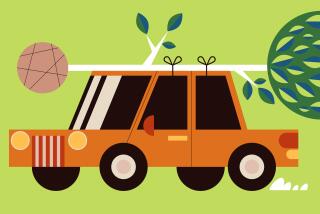Vegas Landscapers Betting on Palm Trees
- Share via
LAS VEGAS — Tom Chacon considers himself a recycler. He sends his “spotters” out across the West, counting on them to buy and uproot prized palm trees from people’s back yards and bring them to Las Vegas--a city that’s gone mad for palms.
“The palm tree business is a booming business in Vegas. Vegas is a hot spot. For how long, I don’t know,” said Chacon, owner of TC Enterprises, a Fontana, Calif., based palm tree company that also has operations in Las Vegas and Phoenix.
Those beautiful palm trees can be seen just about everywhere in Las Vegas. Their big leaves wave on the Las Vegas Strip, almost all the major resorts and most housing developments. While palms may be plentiful, what it takes to get them to this gambling mecca is another story.
“It’s phenomenal,” said Ray Hoffman, division manager at Cedco Landscaping in Las Vegas. “It’s just unbelievable. Every project that we’re doing requires palm trees.”
Hoffman believes the craze started eight years ago when the Mirage opened with palm trees planted outside and preserved palms gracing the lobby.
Now every casino wants palm trees.
“It’s really a craze. It’s a fad too,” Hoffman said.
Demand is so high here that landscaping companies have palm tree “spotters,” who patrol neighborhoods all over the western United States looking for palms sprouting from yards and homeowners ready to bargain. Spotters usually work on commission, so spotting is a daily business.
“Usually they think there’s some kind of a catch,” said Hoffman, who employs eight or nine groups of spotters. “People are leery. We just want your tree!”
Spotters look in yards, fields and nurseries for palms and can offer up to $1,000 per tree. The hardest palm to acquire, the Canary Island palms, are worth the most money.
After a tree is spotted and if the homeowner wants to sell, a permit is obtained and the tree is inspected for accessibility. If it has had enough water and has few scars, it is uprooted from the yard by crane and then a substitute tree is put in its place.
The whole process, plus transporting the tree to Las Vegas by truck, costs about $4,000.
“Every day, when I’m out driving around town, I’m always photographing them, looking in people’s yards,” said Hoffman, who keeps a log book of palm transactions and photographs of palms people want to get rid of.
Chacon started his company 15 years ago before the palm craze hit. His business is booming now, especially in Las Vegas, where 60% of the company’s jobs are.
“I like the idea of recycling or saving something that people are sometimes going to cut down, and putting them in an area and watching other people enjoy them. And, of course, you make money doing it,” he said.
His spotters have also gone as far away as Texas and Florida to find palms.
“It’s all about being intense, being a hunter,” said Chacon, whose company found palms for several Las Vegas resorts, including the Stratosphere Hotel, Santa Fe Hotel & Casino and Sunset Station.
“A lot of people don’t want to get rid of their trees, but a lot of people do. So it’s hit and miss,” he said.
Las Vegas’ palm trees give the city an upscale Palm Springs look and are increasingly popular because they take the heat well and make a dramatic impression, Hoffman said.
Ken Lambert, project manager for Clark County, said resorts are spending more money on landscaping to entice tourists to their properties.
Two years ago, owners of Strip resorts approached the county about sprucing up the barren medians along Las Vegas Boulevard. They wanted the landscaping to complement the aesthetics of their hotels.
Lambert said all the resorts agreed that the tropical theme was something that would be a good tie-in.
Along with 1,000 lights, 1,500 palm trees were planted along four miles of the Strip medians. The $15-million project, funded entirely by the private sector, was completed last year. Most of the palms were located by spotters.
There are some hazards, though, to the beauty of the palms.
“Sometimes you get people who drive a car into one. It’s only happened a couple of times,” Lambert said.
Some of the older trees could cost $11,000 to replace, he said.
For those homeowners thinking their palms will bring in big money, Chacon warns that not all palms are worth money, especially if they are too difficult to remove.
More to Read
Sign up for The Wild
We’ll help you find the best places to hike, bike and run, as well as the perfect silent spots for meditation and yoga.
You may occasionally receive promotional content from the Los Angeles Times.






